Alloposidae
Haliphron atlanticus
Richard E. YoungIntroduction
Females of Haliphron (= Alloposus) atlanticus are very large, reaching 400 mm ML or a total length up to 2m (Nesis, 1982). Body tissues are gelatinous; the mantle is short and broad and the head wide; the eyes are large and the short arms have a deep web. The funnel is embedded in head tissue. Males are much smaller than females but are relatively large (ca. 300 mm total length) for an argonautoid. The hectocotylus develops in an inconspicuous sac in front of the right eye which gives the male the appearance of having only seven arms (see below). The hectocotylus detaches at mating. Females brood their eggs, which are attached to the oral side of the arm bases near the mouth (Young, 1995).
Brief diagnosis:
An argonautoid ...
- of gelatinous consistency with complex funnel locking-apparatus.
Characteristics
- Head
- Beaks: Descriptions can be found here: Lower beak; upper beak.
- Beaks: Descriptions can be found here: Lower beak; upper beak.
- Arms
- Suckers mostly in two series but grade to single series near mouth.
- Hectocotylus with papillate lateral fringes from base to spermatophore reservoir; open spermatophore groove.
- Extensive web between all arms.
Figure. Oral view of brachial crown of H. atlanticus showing deep web and sucker arrangement, ca. 70 mm ML. Drawing from Verrill, 1881.
- Suckers mostly in two series but grade to single series near mouth.
- Sexual dimorphism
- Male much smaller than female but not dwarf.
- Male much smaller than female but not dwarf.
- Head: Radula
- First lateral tooth much smaller than rachidian or second lateral tooth.
- First lateral tooth much smaller than rachidian or second lateral tooth.
- Funnel
- Funnel locking-apparatus with lateral folds on the funnel and corresponding grooves on the mantle.
- Funnel locking-apparatus with lateral folds on the funnel and corresponding grooves on the mantle.
- Body shape
- Body short, broad.
- Body short, broad.
- Swim bladder
- Hydrostatic organ (swim bladder) present dorsal to digestive system.
- Hydrostatic organ (swim bladder) present dorsal to digestive system.
- Water pores
- Water pores absent.
Comments
Unlike other members of the argonautoid families, Haliphron has a remnant of the true shell - a short, thick almost gelatinous stylet (Voight, 1995). H. atlanticus, like other members of the argonautoid families except species of Argonauta, has a hydrostatic organ (Bizikov, 2004).
Nomenclature
A list of all nominal genera and species in the Alloposidae can be found here. The list includes the current status and type species of all genera, and the current status, type repository and type locality of all species and all pertinent references.
Life History
As in all argonautoids, the male has its hectocotylus coiled in a sac. In Haliphron this is located beneath the right eye and due to the thick gelatinous tissue on the octopod, it is easily overlooked. Indeed one such animal was described as a new species and genus, Heptapus danae (Joubin, 1929), based on the apparent presence of only seven arms.

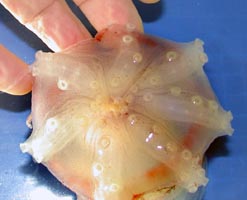
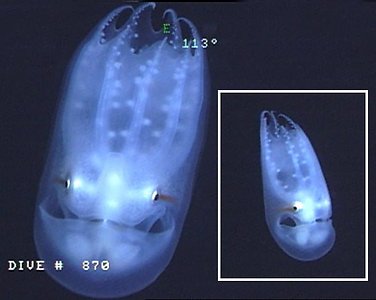
Figure. Oral views of three males of H. atlanticus showing what appears to be just seven arms. Top left - Photograph by Ron Gilmer. Top right - Photograph by R. Young, R/V G. O. Sars, Mar-Eco cruise, North Atlantic.
Bottom - Two in situ views of the same octopod (ventral view at left, side view at right) taken by an MBARI ROV at 388m. © 2013 MBARI.
Below is the detached hectocotylus from a mature male.


Figure. Hectocotylus of H. atlanticus, oral view, ca 25 cm in length. Photograph by M. Vecchione.
A large, brooding female was observed from a submersible off Hawaii at 270 m (top photograph below). The octopod was drifting just above the bottom and was carrying eggs that were held within the web and near the mouth (Young, 1995). The female was badly damaged as can be seen in the photograph by the truncated dorsal arms and the crease in one of the lower arms. Presumably the female was near the end of the brooding period and would not survive long after all young had hatched. The white arrow in the video frame to the right points to the eggs. The video of this octopod can be seen at Cephalopods in Action. A second H. atlantica was photographed in nearly the same locality on another occasion and it, also, appears to be a brooding female (bottom two photographs).

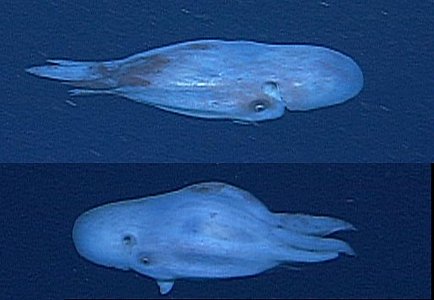
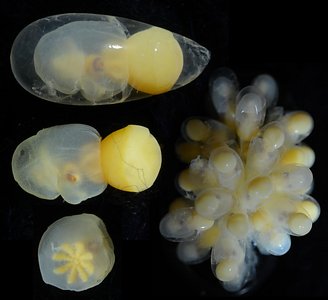

Figure. Top left - Oral view of a female H. atlanticus ca. 1 m in diameter, off Hawaii. brooding a small batch of eggs (arrow). Video frame from the submersible Pisces V, Hawaii Undersea Research Laboratory (from Young, 1995). Top right - Two side views of a female H. atlanticus, swimming near the ocean floor at 519 m, that appears to be brooding eggs (ie, bowed arms, light color within arms). In situ photographs taken from an MBARI ROV. Photographs © 2013 MBARI.
Bottom left - Piece of an egg bundle with eggs 8 mm in length containing embryos of H. atlanticus that was captured in an open trawl that fished at about 300 m depth off the Cape Verde Islands. Bottom right -Side view of a hatchling or near-hatchling of H. atlanticus, north Atlantic, 5.2 mm ML. Drawing by Joubin (1929, via Hochberg et al., 1992).
Hatchlings are rarely taken in the near-surface plankton and presumably reside in deep water (Personal observation).
Habitat
This species is widely distributed from tropical to high latitudes and occupies meso- to bathypelagic depths. It is commonly associated with slopes of land masses. The habitat of this octopod is unusual. It has been captured in bottom trawls and videotaped swimming within centimeters of the ocean floor (brooding female) suggesting a benthopelagic habitat along the slope. However, it has also been taken from the open ocean thousands of meters from the ocean floor and hundreds of miles from the nearest slope. H. atlanticus is a common food item of blue sharks off New England, USA, and sperm whales near the Azores Isl. (M. Vecchione, pers. comm.).
References
Bizikov, V. A. 2004. The shell in Vampyropoda (Cephalopoda): Morphology, functional role and evolution. Ruthenica. Supplement 3: 1-88.
Naef, A. 1921/23. Cephalopoda. Fauna und Flora des Golfes von Neapel. Monograph, no. 35.
Nesis, K. N. 1982. Abridged dey to the cephalopod mollusks of the world's ocean. 385+ii pp. Light and Food Industry Publishing House, Moscow. (In Russian.). Translated into English by B. S. Levitov, ed. by L. A. Burgess (1987), Cephalopods of the world. T. F. H. Publications, Neptune City, NJ, 351pp.
Sasaki, M. 1929. A monograph of the dibranchiate cephalopods of the Japanese and adjacent waters. Journal of the College of Agriculture, Hokkaido Imperial University, 20(Supplementary number):1-357.
Verrill, A.E. 1881. The cephalopods of the north-eastern coast of America. Part II. The smaller cephalopods, including the "squids" and the octopi, with other allied forms. Trans. Connecticut Acad. Sciences, 5: 259-446.
Young, R. E. 1995. Aspects of the natural history of pelagic cephalopods of the Hawaiian mesopelagic-boundary region. Pacific Science, 49: 143-155.
Title Illustrations

| Scientific Name | Haliphron atlanticus |
|---|---|
| Comments | Photographed aboard the R/V G. O. Sars, Mar-Eco cruise, central North Atlantic. |
| Sex | Male |
| View | Lateral |
| Size | 54 mm ML |
| Image Use |
 This media file is licensed under the Creative Commons Attribution-NonCommercial License - Version 3.0. This media file is licensed under the Creative Commons Attribution-NonCommercial License - Version 3.0.
|
| Copyright |
© 2004

|
About This Page

University of Hawaii, Honolulu, HI, USA
Page copyright © 2016
 Page: Tree of Life
Alloposidae . Haliphron atlanticus .
Authored by
Richard E. Young.
The TEXT of this page is licensed under the
Creative Commons Attribution-NonCommercial License - Version 3.0. Note that images and other media
featured on this page are each governed by their own license, and they may or may not be available
for reuse. Click on an image or a media link to access the media data window, which provides the
relevant licensing information. For the general terms and conditions of ToL material reuse and
redistribution, please see the Tree of Life Copyright
Policies.
Page: Tree of Life
Alloposidae . Haliphron atlanticus .
Authored by
Richard E. Young.
The TEXT of this page is licensed under the
Creative Commons Attribution-NonCommercial License - Version 3.0. Note that images and other media
featured on this page are each governed by their own license, and they may or may not be available
for reuse. Click on an image or a media link to access the media data window, which provides the
relevant licensing information. For the general terms and conditions of ToL material reuse and
redistribution, please see the Tree of Life Copyright
Policies.
- Content changed 16 November 2016
Citing this page:
Young, Richard E. 2016. Alloposidae . Haliphron atlanticus . Version 16 November 2016 (under construction). http://tolweb.org/Haliphron_atlanticus/20200/2016.11.16 in The Tree of Life Web Project, http://tolweb.org/




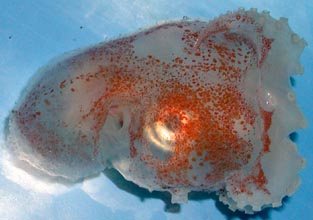


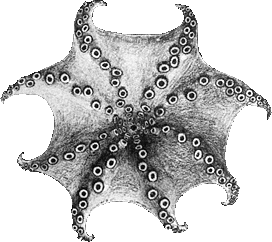
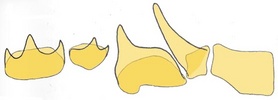
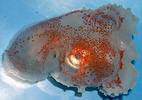



 Go to quick links
Go to quick search
Go to navigation for this section of the ToL site
Go to detailed links for the ToL site
Go to quick links
Go to quick search
Go to navigation for this section of the ToL site
Go to detailed links for the ToL site